My favorite kind of bread is without any doubt a sourdough bread from Skagen. Big holes in the crumb, lightly tangy, crunchy crust, and poppy seeds and sunflowers that are toasted because of the baking. This is my recipe for sourdough bread from Skagen heavily inspired by Maurizio Leo’s recipe for Seeded Sourdough.
If you are just here for the recipe, you can press the button underneath to be automagically transported to the recipe:
Jump to RecipeYou need an active sourdough starter for this sourdough bread from Skagen recipe
To bake this bread you will need an active sourdough starter. If you don’t have one, I’d recommend you go watch my video on YouTube.
A sourdough starter contains natural yeast, that will help your bread to rise without the use of commercial yeast, which means that you can make awesome bread with three ingredients: flour, water, and salt.
It’s not very hard to make a sourdough starter, but there are some things you need to be aware of. I will explain it all.
Special techniques for better bread
This is an advanced recipe. It takes about 24 hours from start to finish and requires some next-level techniques. if you follow this recipe it will vastly exceed anything you get at a bakery.
If you are new to sourdough baking, maybe you want to start somewhere where it’s a bit easier. You can try my “The world’s easiest sourdough bread” or “Sourdough bread for beginners“. That should get you started.

Tools that will make things easier
You need some tools to be able to bake sourdough bread.
Ad links! The links for ingredients/items in this section are affiliate links, which means I will get a commission if you purchase the product!
- Bench scraper – this is the only tool you can’t do without. You will absolutely need a bench scraper
- Danish dough whisk – you can use your hands or a spoon if you don’t want this
- Bannetons – you can use a bowl lined with a dishtowel as a substitute
- Spray bottle – I use this for spraying bannetons, spraying loaves to get seeds to stick, and saturating the oven with steam
- Brød and Taylor Folding Proofer – I own this and it is a huge help in making sure your dough has the best opportunity to proof
The road to awesome bread
I hope you will try my recipe for sourdough bread from Skagen. It’s an experience and when you cut into the loaf and see the crumb you be so happy. Okay, you may not be able to put jam directly on the bread, but you can always put a piece of cheese underneath to hold the jam. Not really a trade-off for me.
Please share this recipe for sourdough bread from Skagen on social media
This is my recipe for sourdough bread from Skagen. If you like the recipe please consider sharing it with like-minded bread lovers on social media.
If you make it and post it on Instagram, please tag me as @foodgeek.dk so I can see it. That would make me very happy.
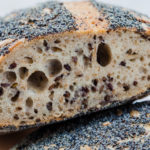
Sourdough Bread from Skagen
Ingredients
Levain
- 25 gram sourdough starter 50%
- 25 gram bread flour 50%
- 25 gram whole wheat flour 50%
- 50 gram water 100%
Dough
- 673 gram bread flour 76,5%
- 140 gram semolina flour 15,9%
- 67 gram whole wheat flour 7,6%
- 644 gram water 73,2%
- 19 gram fine salt 2,2%
- 88 gram poppy seeds 10,0%
- 51 gram sunflower seeds 5,8%
Toppings
- poppy seeds
- sunflower seeds
Instructions
Levain – About 9:00/9 a.m.
- Make the levain by mixing bread flour, whole grain wheat flour, water, and mature sourdough starter in a big enough container to grow to about twice the size. Your starter must be super active and bubbly.
- Put it somewhere warm and let the starter do its job.
Autolyse – About 15:00/3 p.m.
- Weight out and mix all three flours.
- Measure out 544 grams of water.
- Add the water to the flour and mix it so that all the flour is completely hydrated. I usually use a Danish dough whisk to mix in the beginning, and when the dough comes together, I fold the dough over itself until it's mixed.
- Put a dishcloth over the top and put it somewhere warm.
Soak the seeds- About 15:10/3.10 p.m.
- Put the poppy seeds and sunflower seeds in a bowl, pour 150 grams of boiling water over and let them soak.
Make the dough – About 17:00/5 p.m.
- Put the levain over to the top of the dough. Mix it thoroughly.
- When you have mixed the dough, it's time to build some gluten in it using some stretch and folds.
- Put the bowl in front of you. Grab the dough in the back of the bowl with both hands. Stretch it as far as it goes without tearing, and fold it down over the dough.
- Turn the bowl about 1/8 and repeat about 30 times.
- Spread the salt over the dough and pour 100 grams of water over and mix it into the dough.
- Let the dough rest for 30 minutes, then we will be doing five stretch and folds every half hour.
First stretch and fold – About 17:40/5.40 p.m.
- Do a stretch and folds the following way:
- Do a stretch and fold and turn the bowl 180°.
- Do a stretch and fold and turn the bowl 90°.
- Do a stretch and fold and turn the bowl 180°.
- Do a stretch and fold. Now you've done one from each direction.
- Put a dishcloth over the top and let the dough rest.
Second stretch and fold – About 18:10/6.10 p.m.
- Do a stretch and fold as described above.
- Spread the seeds over the top and blend them into the dough using wet hands.
Third to fifth stretch and fold – About. 18:40./6.40 p.m., 19:10/7.10 p.m., 19:40/7.40 p.m.
- Do a stretch and fold as described above; after the fifth, let the dough rest.
Divide and preshape – About 20:50/8.50 p.m.
- Pour the dough out onto an unfloured table.
- Divide the dough in half.
- I use my bench scraper to move the dough because it can be pretty wet.
- I usually do a preshape the following way:
- Push the scraper under the dough in the front. Stretch it up and fold it about three quarters in over the dough. Repeat from the top, right, and left side.
- Push the scraper under the dough and flip it over, so the top is down towards the table.
- Put the scraper behind the dough and move it forward. The front of the dough will be pushed under the ball and create tension on the top of the dough.
- When you can't get any further, then hold the dough lightly and pull the scraper away from the dough.
- Then place the scraper in front of the dough and push forward; while moving, turn it around, and pull it towards yourself again. Keep going until the dough is very tight.
- Continue with the other dough ball and let them rest under a damp dishcloth
Shaping of the dough
- Prepare a dishcloth with poppy seeds and sunflower seeds in one layer. These seeds shouldn't be soaked.
- To shape the dough, follow the instructions from the preshape.
- When you've shaped the dough, spray it with some water from the spray bottle; flip it onto the dishcloth. Roll it around to get seeds on the top and the sides.
- Then move it to a banneton lined with a dishtowel.
- Repeat with the other dough ball.
Rest and retard in the fridge – About 21:15/9 p.m.
- Put both bannetons in plastic bags and put them in the fridge until the following day.
Heat the oven – About 6:15/6.15 a.m.
- If you have a baking steel or a pizza stone, put it in the oven. It'll help keep the temperature constant even when you open the oven door.
- Put your dutch oven or combo cooker in the oven and heat it to 260ºC/500ºF. If your oven doesn't go this high, put it as high as possible.
Bake the breads – About 7:15/7.15 a.m.
- Take a loaf out of the fridge.
- Cut parchment paper about the same size as the bread and put it on the banneton. Turn it over to a peel or something that can help you move the dough to the oven later.
- Score the dough using a very sharp knife. If you cut at an angle, you can get a beautiful ear.
- Open the oven and put the dough in the dutch oven. Be careful, it's hot, and it can be challenging to get in. I use a combo cooker because you can turn it upside down and put the dough in the "frying pan" part.
- Put the lid on top and push it into the oven—bake for 20 minutes.
- Open the oven and take the top off the dutch oven so that the crust can get some color.
- Turn the oven down to 230ºC/450ºF and bake until you have a beautiful golden crust. 25-30 minutes.



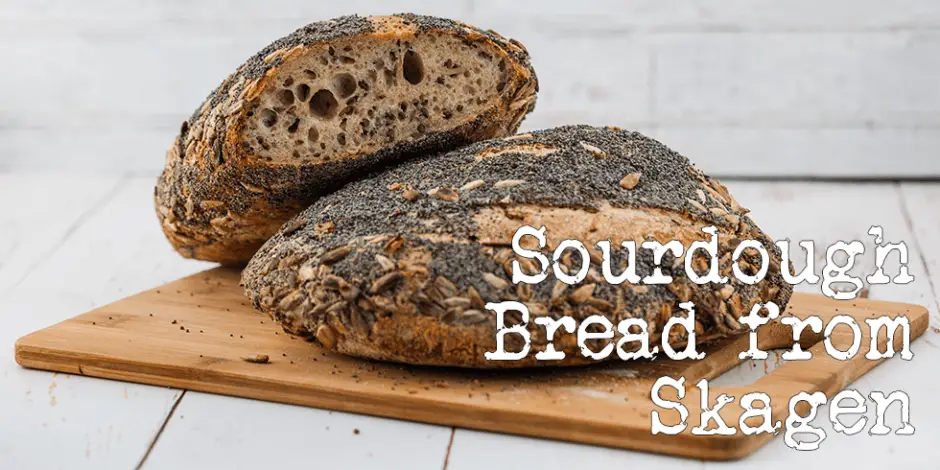

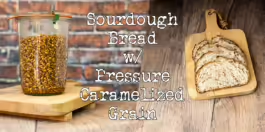
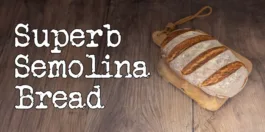

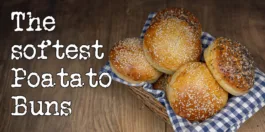


Pingback: Best bundt cake recipe - orange and poppy seed - Foodgeek
Hi Sune,
How long is the resting time between pre-shape and final shaping? Is there a video for this recipe?
Thanks 😊
20 minutes is good. No video, this is from before I made videos for youtube, and when I was just getting into sourdough 🙂
Hei Sune,
Thanks for all the great videos and the really useful bread calculator, which I’m frequently using now.
I have a couple of questions about this recipe for the Skagen sourdough bread. It says that the hydration level is 75%, but that is excluding the 150g of water used for the seed soaker, right? If my math is correct the hydration level is 90% with the seed soaker included.
I tried baking this recipe, but the bread turned out a bit flat. It resembled more of a frisbee than the tall sourdough loaves I have achieved lately. The loaf was quite dense with a few big holes, which I believe is a sign of under-fermentation. I noticed that the fermented-flour-to-total-flour ratio is 7%, which is the lowest I have tried so far. What are your thoughts on increasing this to 15% please? I adjusted the recipe using your bread calculator (https://fgbc.dk/657)
Thanks,
Jon
The water in the soaker gets released as you mix in the seeds, but it reabsorbed later. The hydration is still 75% 🙂
About the inoculation. Use it to change your fermentation time. The less you put in, the longer the bread will need to ferment (thus more sour).
I just made the Skagen bread. I visited Denmark three years ago and loved the bread. I started making sourdough bread about six weeks ago and have been getting good results. This was my first time with your recipe and it was definitely the most challenging I’ve made. The bread turned out to be delicious and reminded me of the chewy texture with lots of seeds that I enjoyed in Denmark. One of the difficulties I had was incorporating the seeds that were soaked ahead. The poppy seeds tended to stay clumped together because they are wet and swollen. I wasn’t sure how to get them well distributed. There are still some small clumps in the finished bread. They’re soft and tasty enough but would like them better distributed. Any tips you have would be appreciated. Thank you for your recipe.
When you incorporate the seeds, smear it thinly on top of the dough.
If after the stretch and folds they still don’t seem well enough incorporated, do another set 🙂
Hi Sune. Thanks for all your content! Quick question, the seeds that you lay on the dish cloth that end up on the crust of the bread, are these soaked in boiling water as well or fresh from the packet?
I can’t find semolina flour, what can I substitute? Could I use whole wheat and add some gluten flour?
Any whole-grain flour or even just bread flour 🙂
Hi
I am loving your videos. My standard sourdough has improved immensely. I am a little confused in relation to breads including seed soaked grain. Is the soaker water included in the calculation for flour/water ratio? Also are the grains included in the same calculation.
Many thanks
The water is not included because it will stay in the seeds and not make the dough more hydrated. You may feel the dough getting more slack just after the seeds have been added, but it will disappear again 🙂
Pingback: Seeded Sourdough Bread Recipe - Using lamination - Foodgeek
Can the starter be too active? The reason I ask is that the last batch of levain that I made for the poppy seed sourdough had grown nicely, but by the time I added it to the dough it collapsed. It didn’t seem as active during the bulk rise.
The levain is fed 1:2:2 in this recipe. The bread is fed the levain at the ratio of about 1:5:5, so it will be appropriately slower.
Also, the temperature that you proof at will determine how fast your bread will rise.
Should the seeds that go on the crust of the bread be soaked prior to sticking them on?
No. it’s not important, unless you get burnt seeds when you bake. I’ve never had that problem though 🙂
Sune, This recipe is from about three years ago. Since then you have made a lot of changes in the overall preparation, which would make this process a bit shorter. Would you consider updating this recipe to your newer techniques? I am going to try it today but with mixing the flours, water, salt and starter all at the start, like most of your newer recipes are done. I made this bread in the past using the original recipe. Now I want to try to shorten it, based on all your experiments. One thing needs clarification.. You tell us how much soaked seeds to put in the dough but when you say to turn over the ball and rub the sprayed top in the seeds on the towel you don’t mention if they should also be soaked or not. Thanks.
For the sake of spam, I have to approve comments before they show up 🙂
What I am doing right now is that every time I convert a recipe for a 60-second video, I update the recipe for my newer methods so it is going to happen. You can basically use the same method as my master recipe and add the soaked seeds in with the first mix 🙂
The seeds on top are extra seeds that are not soaked. I will update the recipe to reflect that.